- Home
- Garden Wildlife
- Insects
- Lepidoptera
- Root eating moths
Root-feeding moths
Most moths have larvae that feed on above-ground parts of plants but the caterpillars of some moths live in the soil where they feed on the roots of a wide range of plants.
Species in Britain and Ireland
Moths with root-eating larvae belong to the Hepialidae and Noctuidae families of moths. All of the five Hepialidae moths found in Britain and Ireland are root eaters. The species most frequently encountered in gardens are the ghost swift moth, Hepialus humuli, and the common swift moth, Hepialus lupulinus. Jennifer Owen also recorded the orange swift Hepialus sylvina.
Above Left: heart and dart moth, Agrotis exclamationis. Centre: shuttle-shaped Dart Agrotis puta. Right: cutworm larva of heart and club moth, Agrotis clavis
Biology
Caterpillars of swift moths have relatively long and slender bodies up to 35mm long. They are white with a brown head, superficialy reminiscent of some beetle larvae. Larvae of the Agrotis and Euxoa species are up to 40mm long and have thicker bodies than Hepialus species. They are often soil coloured with a less obvious colour contrast between the head and body. The caterpillars eat the roots and stem bases of a wide range of cultivated plants and wild flowers.
Life cycle
Female swift moths scatter their eggs randomly while they are in flight. After hatching the larvae go into the soil where they feed on plant roots. They will also bore into bulbs, corms and tubers. The larvae of ghost swift moth feed for two summers before pupating in late spring. The common swift moth completes its development in one year.
Agrotis and Euxoa species deposit their eggs on low-growing plants. The caterpillars go into the soil and feed in a similar manner to those of swift moths. There is one generation a year. Agrotis species overwinter in the soil as larvae but the garden dart overwinters as eggs.
Role of moths with root-eating larvae in gardens
Root-eating caterpillars can be damaging to some cultivated plants, as well as feeding on the roots of weeds and other wild flowers. Annual flowers and small herbaceous plants are most at risk in flower beds. In the vegetable garden, young plants can be killed, while root crops, such as carrots, beetroot and potato tubers can have cavities eaten in them.
Other sources of information
Website
Web site of Butterfly Conservation Moths
Website of UK Moths Hepialidae
Books
Porter, J. (2010) Colour Identification Guide to the Caterpillars of the British Isles. Apollo Books
Skinner, B. and Wilson D.W. (2009) Colour Identification Guide to the Moths of the British Isles. Apollo Books
Townsend, M., Waring, P. and Lewington R. (2017) Concise Guide to the Moths of Great Britain and Ireland. British Wildlife Publications
Page drafted by Andrew Halstead, reviewed by Andrew Salisbury, edited by Steve Head
Only a small minority of the Noctuidae are root eaters. They include some abundant species, the turnip moth, Agrotis segetum; heart and club moth, Agrotis clavis; heart and dart moth, Agrotis exclamationis; shuttle-shaped dart, Agrotis puta; and garden dart, Euxoa nigricans. The caterpillars of these moths are commonly known as cutworms.
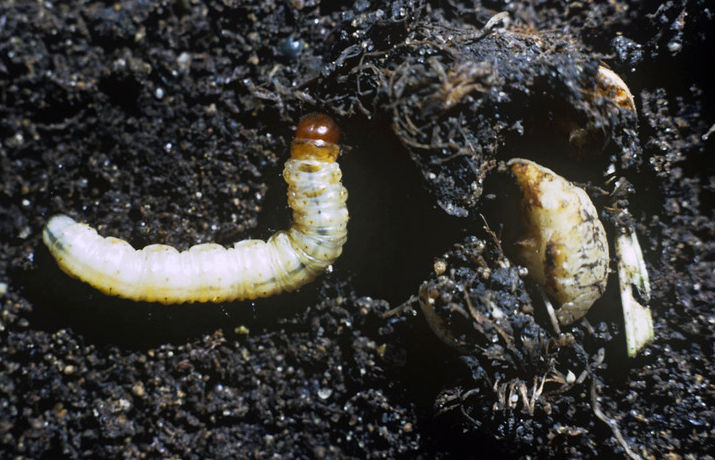
![Common swift moth Photo: Ben Sale from UK [CC BY 2.0 (https://creativecommons.org/licenses/by/2.0)]](images/(0017)_Common_Swift_(Hepialus_lupulinus)_(14241328365).jpg)
.jpg)
Swift moths. Top left: common swift moth Hepialus lupulinus Top right: common swift larvae with damaged crocus corm.
Left: ghost swift moth Hepialus humuli, pair with female left, male right
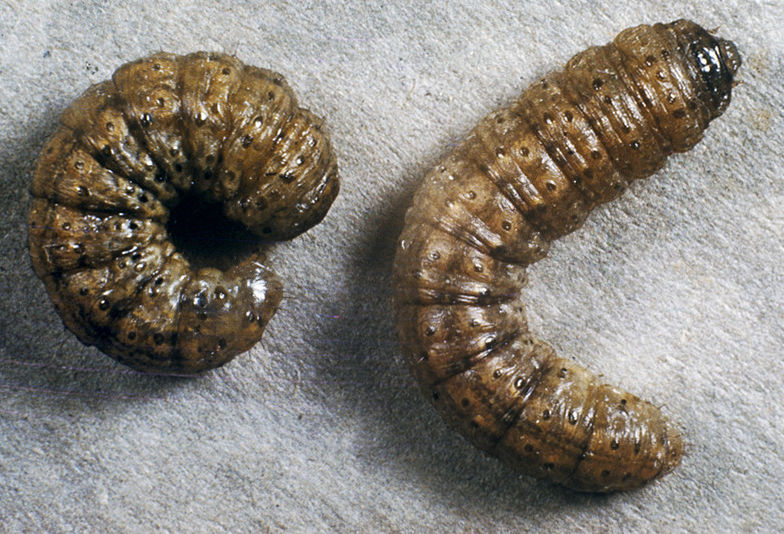
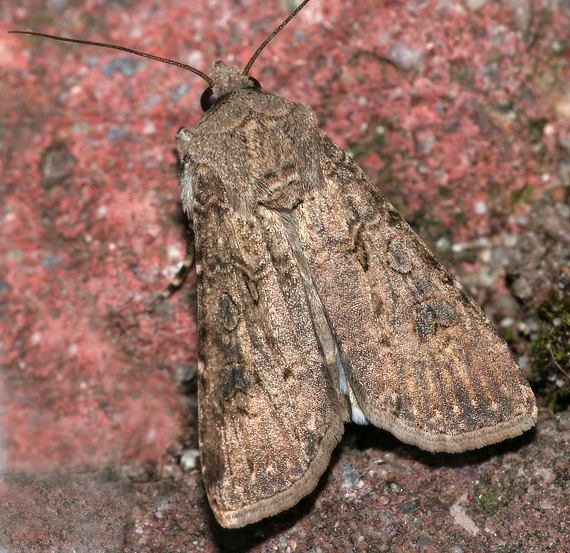
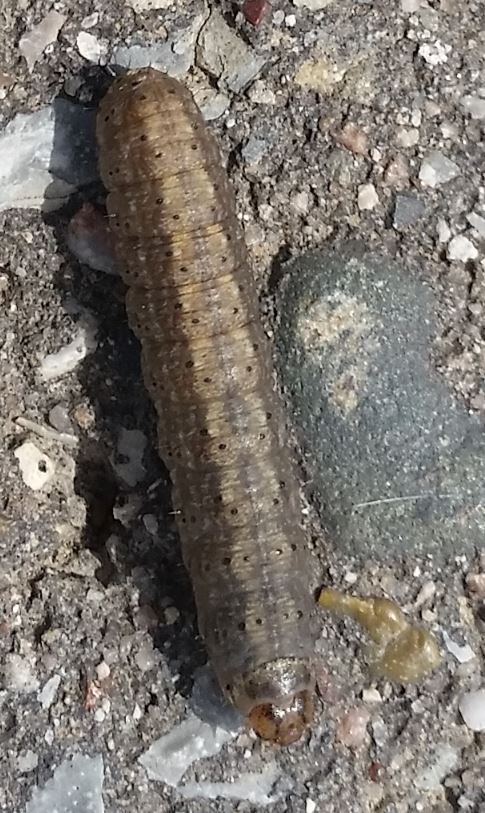
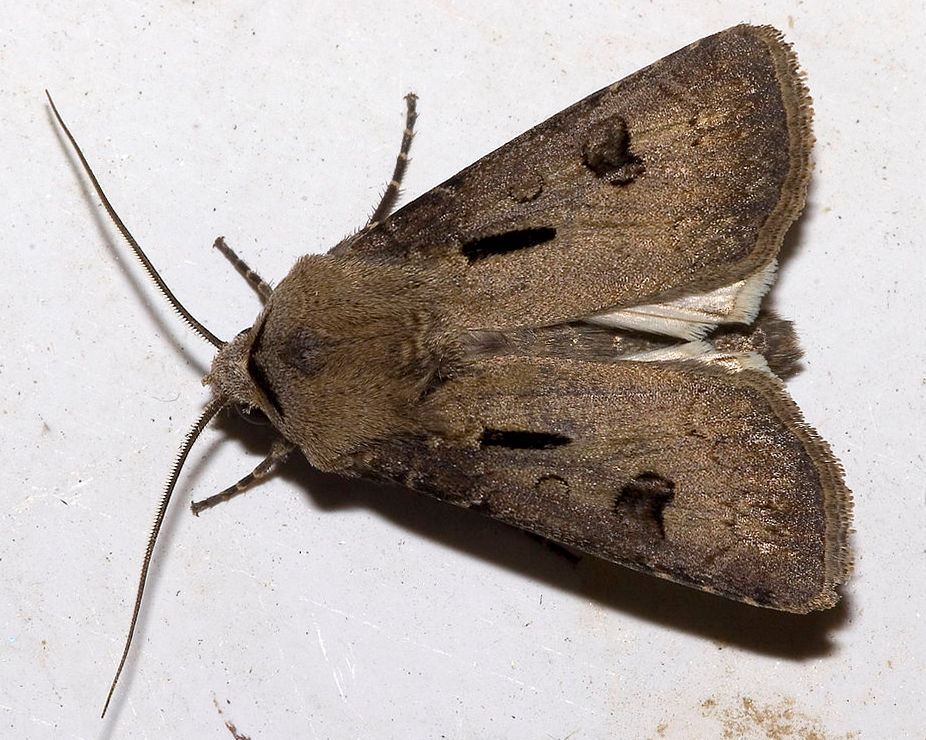
![Shuttle-shaped Dart (Agrotis puta) Photo: by Ben Sale from UK - [2092] CC BY 2.0, https://commons.wikimedia.org/w/index.php?curid=63706894](images/1024px-(2092)_Shuttle-shaped_Dart_(Agrotis_puta)_(27084891621).jpg)
Turnip moth Agrotis segetum: Left adult, right cutworm larvae
Root-feeding moths
Most moths have larvae that feed on above-ground parts of plants but the caterpillars of some moths live in the soil where they feed on the roots of a wide range of plants.
Species in Britain and Ireland
Moths with root-eating larvae belong to the Hepialidae and Noctuidae families of moths. All of the five Hepialidae moths found in Britain and Ireland are root eaters. The species most frequently encountered in gardens are the ghost swift moth, Hepialus humuli, and the common swift moth, Hepialus lupulinus. Jennifer Owen also recorded the orange swift Hepialus sylvina.
Root-feeding moths
Most moths have larvae that feed on above-ground parts of plants but the caterpillars of some moths live in the soil where they feed on the roots of a wide range of plants.
Species in Britain and Ireland
Moths with root-eating larvae belong to the Hepialidae and Noctuidae families of moths. All of the five Hepialidae moths found in Britain and Ireland are root eaters. The species most frequently encountered in gardens are the ghost swift moth, Hepialus humuli, and the common swift moth, Hepialus lupulinus. Jennifer Owen also recorded the orange swift Hepialus sylvina.
![Common swift moth Photo: Ben Sale from UK [CC BY 2.0 (https://creativecommons.org/licenses/by/2.0)]](images/(0017)_Common_Swift_(Hepialus_lupulinus)_(14241328365).jpg)
Root-feeding moths
Most moths have larvae that feed on above-ground parts of plants but the caterpillars of some moths live in the soil where they feed on the roots of a wide range of plants.
Species in Britain and Ireland
Moths with root-eating larvae belong to the Hepialidae and Noctuidae families of moths. All of the five Hepialidae moths found in Britain and Ireland are root eaters. The species most frequently encountered in gardens are the ghost swift moth, Hepialus humuli, and the common swift moth, Hepialus lupulinus. Jennifer Owen also recorded the orange swift Hepialus sylvina.
.jpg)
Swift moths. Top left: common swift moth Hepialus lupulinus Top right: common swift larvae with damaged crocus corm.
Left: ghost swift moth Hepialus humuli, pair with female left, male right


Turnip moth Agrotis segetum: Left adult, right cutworm larvae
Only a small minority of the Noctuidae are root eaters. They include some abundant species, the turnip moth, Agrotis segetum; heart and club moth, Agrotis clavis; heart and dart moth, Agrotis exclamationis; shuttle-shaped dart, Agrotis puta; and garden dart, Euxoa nigricans. The caterpillars of these moths are commonly known as cutworms.


![Shuttle-shaped Dart (Agrotis puta) Photo: by Ben Sale from UK - [2092] CC BY 2.0, https://commons.wikimedia.org/w/index.php?curid=63706894](images/1024px-(2092)_Shuttle-shaped_Dart_(Agrotis_puta)_(27084891621).jpg)
Above Left: heart and dart moth, Agrotis exclamationis. Centre Shuttle-shaped Dart Agrotis puta. Right :cutworm larva of heart and club moth, Agrotis clavis
Biology
Caterpillars of swift moths have relatively long and slender bodies up to 35mm long. They are white with a brown head, superficialy reminiscent of some beetle larvae. Larvae of the Agrotis and Euxoa species are up to 40mm long and have thicker bodies than Hepialus species. They are often soil coloured with a less obvious colour contrast between the head and body. The caterpillars eat the roots and stem bases of a wide range of cultivated plants and wild flowers.
Life cycle
Female swift moths scatter their eggs randomly while they are in flight. After hatching the larvae go into the soil where they feed on plant roots. They will also bore into bulbs, corms and tubers. The larvae of ghost swift moth feed for two summers before pupating in late spring. The common swift moth completes its development in one year.
Agrotis and Euxoa species deposit their eggs on low-growing plants. The caterpillars go into the soil and feed in a similar manner to those of swift moths. There is one generation a year. Agrotis species overwinter in the soil as larvae but the garden dart overwinters as eggs.
Role of moths with root-eating larvae in gardens
Root-eating caterpillars can be damaging to some cultivated plants, as well as feeding on the roots of weeds and other wild flowers. Annual flowers and small herbaceous plants are most at risk in flower beds. In the vegetable garden, young plants can be killed, while root crops, such as carrots, beetroot and potato tubers can have cavities eaten in them.
Other sources of information
Website
Web site of Butterfly Conservation Moths
Website of UK Moths Hepialidae
Books
Porter, J. (2010) Colour Identification Guide to the Caterpillars of the British Isles. Apollo Books
Skinner, B. and Wilson D.W. (2009) Colour Identification Guide to the Moths of the British Isles. Apollo Books
Townsend, M., Waring, P. and Lewington R. (2017) Concise Guide to the Moths of Great Britain and Ireland. British Wildlife Publications
Page drafted by Andrew Halstead, reviewed by Andrew Salisbury, edited by Steve Head












